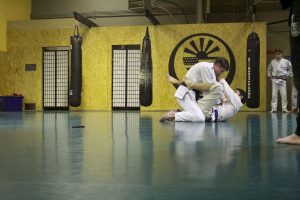Walking into Practical Martial Arts, a mixed martial arts dojo in Corte Madera, on a Thursday night at five o’clock, one is met by the smell of sweat, the hum of casual conversation, and the sight of about ten tangles of limbs and white uniforms dispersed on a teal mat.

Martial arts encompasses the practices of boxing, Muay Tai, Brazilian jiu-jitsu, and wrestling. Instead of just competing, students set personal goals to constantly improve themselves physically and mentally.
A martial arts student’s skill level is signified by their belt color. A white belt marks a beginner, while a black belt means the student is an expert. Students under the age of 16 can work towards a youth degree black belt, a title that took sophomore Vivienne Ward seven years to earn.
Ward’s commitment to the sport is also demonstrated through her multiple jobs at the dojo, that include working the front desk and teaching summer camps. She has had her youth degree black belt for two years.
“Our teacher says that the black belt shows his belief in us to defend ourselves,” Ward said. “He holds us to a higher standard mentally as well.”
Ward is one of the 16 students at Practical Martial Arts who has a black belt of any degree. For students over the age of 16, the black belt is broken up into degrees, first degree being the least advanced and tenth-degree the most.
“There are only a few people in the world who have a tenth degree black belt. The only woman just passed away a couple years ago,” Ward said. “Our instructor just got his sixth degree, which was a huge deal. His instructors have eighth degree.”
Junior Josh Sparler earned his youth degree black belt after 11 years of training. Last year, Sparler got his first degree black belt.
A youth degree and first degree black belt each require an hour-long test that Sparler and Ward described as the most difficult physical task they have ever completed.
All martial arts students are constantly moving throughout the black belt test since they have to demonstrate skills in multiple fighting styles. There are no breaks during the test.
“One of my fellow testers puked three times and another buddy of mine got a bloody nose starting two minutes in and it didn’t stop bleeding the entire way through. His gi [uniform] was covered in blood,” Sparler said. “No matter what, we all finished the tests.”
According to Sparler, there is also a mental component to the test.
“To reach the first degree black belt takes mostly training and perseverance,” Sparler said, adding that he’s considered quitting in the past. “To achieve a black belt is to just keep going, stick with it, and finish it out to the end.”
Sparler said that he most enjoys the strategic aspect of the sport.
“It’s the idea that you are combining physical strength, speed, and agility with thinking through what you are going to do. You’re always planning your next move,” Sparler said. “It’s not just you hitting a ball as hard as you can, you’re melding your body to defeat another opponent.”




!["I knew I wanted to be a writer. I wasn't a good student [at Redwood], but I wanted to be a writer, and I wanted to paint. I'm self-taught in all of it, which gave me an original voice," Paige Peterson said. (Photo courtesy of Paige Peterson’s website).](https://redwoodbark.org/wp-content/uploads/2025/02/ppeterson.png)

